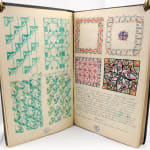Three Czech design and ornament sketchbooks, (c. 1920)
Brno: State Teaching Institute for Women
1320
Further images
-
(View a larger image of thumbnail 1
)

-
(View a larger image of thumbnail 2
)

-
(View a larger image of thumbnail 3
)

-
(View a larger image of thumbnail 4
)

-
(View a larger image of thumbnail 5
)

-
(View a larger image of thumbnail 6
)

-
(View a larger image of thumbnail 7
)

-
(View a larger image of thumbnail 8
)

-
(View a larger image of thumbnail 9
)

-
(View a larger image of thumbnail 10
)

-
(View a larger image of thumbnail 11
)

-
(View a larger image of thumbnail 12
)

-
(View a larger image of thumbnail 13
)

Three quarto volumes, each by a different student at the Institute studying under the learned eye of Joseph Ruzicka, whose professorial stamp of approval appears throughout. Occasionally appearing, too, is...
Three quarto volumes, each by a different student at the Institute studying under the learned eye of Joseph Ruzicka, whose professorial stamp of approval appears throughout. Occasionally appearing, too, is the circular stamp of Statni Pedagogicky Ustav Pro Zeny. Clear in each of the notebooks is the overwhelming influence of modernist design principles emphasizing form and color over strict representation. Among the apparent movements are the dynamic lines of Cubism, the color theory advocated by Wassily Kandinsky and others in the periodical Der Blaue Reiter and the Bauhaus, and the naturalist and folk affinities of Secessionism. The result, here, is a significant archive documenting the concentrated involvement of women in those movements, and by extension into the applied arts. Volume one, by J. Mayerova: block-printed title page, hand-stamped half title, (6)ff notes with drawings interspersed, (2) blank leaves, then (32)ff designs and sketches chiefly in color and most partitioned with tissue guards. Volume two: (14)ff notes with drawings all arranged in the sequence of instruction, full-page watercolor, (67)ff sketches, patterns, drawings in perspective, and original watercolors, concluding with further notes. Volume three: (20)ff notes and annotated drawings, (53)ff drawings in instruction sequence, then 5 leaves blank, (4)ff further notes, 4 leaves again blank, (57)ff lettering designs. Each volume bound differently: volume one in half linen with stamped boards; volume two in half black cloth with gray paper over boards; volume three lacking original boards so with heavy-stock endpapers as wrappers. Mild rubbing to exteriors, else altogether near fine.














